Abstract
Learners are subjects of teaching and they should be accepted in a complex way. It is necessary to innovate, change and complete work methods and forms to make learners harmonically developed. Present educational institutions focus on the development of students´ key competences, such as communicative, personal and interpersonal abilities, the ability to solve problems in a creative and critical way, and the ability to work with modern information technologies. The communicative approach to learners is prevailing in the current systems of teaching of foreign languages – a learner is approached as a teammate. Students are expected to express their own opinions, experience and spheres of interest. The paper focuses on students´ attitudes towards music within the framework of foreign language classes. The second part of the text presents partial results of the long-term research which is being carried out at the Faculty of Education of the University of Hradec Kralove (Czech Republic). This research focuses on primary and secondary school students and their attitudes to music within the framework of the classes of their first foreign language (English) and their second foreign language (German, Russian, Spanish and French). We believe that development of and support to learners´ aesthetic feelings should be an important component of the educational process. Moreover, music can be applied as one of the means which consciously enable and support students´ activation and simultaneously create conditions for learners´ continuous cultivation.
Keywords: Musicforeign language learningmusical skillsstudent´s attitude
Introduction
The involvement of music in foreign language classes can be considered from several points of view. Motivation, the language reception and production, emotions and supported intensity of the language perception are the main points of considerations made about a learner of foreign languages. Before presenting our research results, we feel as highly important to give a characterization of current students of foreign languages, to mention their expectations and also their objections to the current teaching process.
Learners in the process of foreign language teaching
Pedagogický slovník (The Lexicon of Pedagogy) links the term of “learner“ with referring to a human being without any age limitations who is a subject of teaching, which means that children, adolescents or adults can be considered as learners. (Průcha, Walterová, Mareš, 2013, p. 389) Learners and their qualities and development are the main sphere of interest of several scientific disciplines which serve as supporting pillars for the current pedagogy, e.g. developmental and pedagogical psychology, and sociology of childhood and family. Only a learner of foreign languages will be focused on in this paper; it would be irrelevant to deal with all the aspects referring to learners in general.
The prevailing approach of the present tendencies in foreign language teaching is the communicative one, which considers a learner as a teammate. Learners are trained in expressing their own opinions on issues included in texts, in talking about their experience and interests, learners are expected to learn the needed vocabulary and phrases. Present learners have to be very active. Rampillon claims that learners create their knowledge through discovering, comparing, connecting, communicating, trying, evaluating, refusing or confirming, instead of passive accepting and consuming. (Rampillon, 2000, p. 122) In our opinion, the three items listed below and further dealt with are important determiners of learners of foreign languages:
dispositions and talent of learners,
intellectual characteristics of learners,
socio-cultural and socio-economic situation of learners and their families.
The terms of dispositions and talent are defined in inconsistent and even contradictory ways in literature. There are three basic approaches to them: 1) these two terms are considered as synonyms, 2) these two terms express different levels of generality, 3) these two terms express different levels of the development of the abilities. (Mareš, 2013, p. 529) According to the Lexicon of Pedagogy, the term “dispositions” refers in the sphere of pedagogy to an extraordinary component of the personality and is linked mainly with artistic branches, sports, languages and mathematics. (Průcha, Walterová, Mareš, 2013, p. 163) From this definition it is clear that both dispositions and talent are important components in the spheres of music and foreign languages.
The following identifying criteria which were listed by Sternberg in 1993 are generally significant for dispositions and talent:
the criterion of exceptionality – individual beings of the same aged are compared,
the criterion of uniqueness – e.g. a Czech learner excels in English among his/her Czech classmates but s/he would not excel in this subject among English pupils,
the criterion of productivity – dispositions are meaningless if not applied,
the criterion of demonstrability – dispositions must be demonstrable,
the criterion of a social appreciation – this appreciation varies in dependence on various time periods, political systems and cultural backgrounds. (Sternberg, 2002, pp. 185 – 188)
Dispositions are traditionally linked with general intelligence. On the other hand, talent is considered as a special kind of dispositions, i.e. the case when specific abilities are highly developed. Thus dispositions can be understood as certain pre-requisite, and talent can be understood as a practical performance. Concerning music psychology and psychology of foreign language learning, both the terms refer to a qualitatively higher level of “musicality“ and foreign language using. Talent is then considered as a higher level of music dispositions or a higher level of dispositions for languages (however, bilingualism is excluded). Dispositions and talent are determined also by other characteristics, e.g. the individual development of a human being, external interventions, internal processes, the environment, etc., which can play an essential role in the educative process.
It is complicated to specify the language dispositions of an individual being because, among others, the terms of “success“ and “failure“ cannot be exactly defined within the process of language learning. There are many cases considered as “success“ – e.g. a praise expressed by the teacher having the same mother tongue, the ability of understanding of and communicating in a foreign language, the ability of expressing one´s opinion or creating correct written texts or reading texts of specific purposes within the sphere of the learner´s professional or personal interests. Also a situation in which a native speaker does not recognize that the language performance has not been made by a non-native speaker (pronunciation, melody and vocabulary are not noticeable as different) can be considered as a kind of success. Learners are wrongly considered as having a low level of the language dispositions when they miss a skill of learning a language due to insufficient working (learning) habits, a bad organization of the learning process, and a lower level of reasoning abilities or intellect. Different difficulties appear in learning different languages. That is why it can happen that one learner has certain level of quality of language abilities and skills in one language and this level is different in another language produced by the same learner. (Ondráková, 2012, pp. 103-104)
Another variable determining a learner and influencing the educational process is the learner´s intelligence, which is an essential characteristic feature of a personality. Cognitive aspects are emphasized in definitions of intelligence. There are numerous kinds of intelligence (social, emotional, practical, creative, analytical and others), and they have something in common – they refer to the ability to adapt to the environment. Different kinds of adaptions can be required in different social and cultural contexts (Průcha, Walterová, Mareš, 2013, p. 108) Nakonečný (2003, p. 301) views intelligence as an internal disposition for thinking, i.e. the process of understanding and solving of problems. Sternberg (2002, p. 502) views intelligence as two basic abilities: a) that of learning from experience, b) that of adapting to the environment. The issue of intelligence is a burning one in the present pedagogy. As Průcha (2013, p. 110) claims, the still discussed issue is whether intelligence is innate or whether it can get significantly changed through learning, experience and social interactions.
Already in 1983 Howard Gardner proposed a new way of classification of intelligence into the following types: linguistic, logical-mathematical, music, visual-spatial, kinesthetic, inter-personal, intrapersonal and natural. (Gardner, 1999, pp. 101 – 256) Gardner sometimes mentions other kinds of intelligence – e.g. so called existential or spiritual intelligence. Two types of learners´ intelligence have to be essentially considered for our needs – the linguistic intelligence and music intelligence.
According to Howard Gardner, the linguistic intelligence refers to an individual´s ability to understand spoken and written language with the purpose of reaching specific goals. Linguistic intelligence was linked with an increased logical reasoning and better ability to solve problems. According to Gardner, in many cases only verbal aspects are considered, and this can be labelled as verbal intelligence or verbal fluency, which reflects the total linguistic intelligence of an individual. (Gardner, 1999)
Music intelligence is still not clearly characterized. It has been defined by Gardner, but e.g. Spearmann, C. Burt, P. E. Vernon, J. P. Guilford and others have come up with other proposals of its definition and classifications. According to Gardner, a being with a high level of music intelligence is sensitive to sounds, rhythms, tones, melody and music in general. Such a being is able to perceive, reproduce and create music. According to Sedlák, music intelligence is a broad-based term which includes perceptive promptness, mental operations, organization of cognitive structures, fast adaptation to new problems, memory, learning processes and ability to understand relations between phenomena. (Sedlák, 2013, p. 189) The term of music intelligence is linked with a disposition basis for music thinking. This kind of thinking enables special operations in the senso-motoric and thinking areas. Research into intelligence is still in process and has its inevitable development which must be reflected also by the educational process. That is why this issue has to be considered also within the framework of our research.
Other two essential factors which have an impact on the educative process and which have to be considered are the socio-cultural and socio-economic situations of learners and their families. According to Kalhous, not only are differences between the learners not removed by the educative process, they are even made bigger. The learners supported and motivated by their families make the biggest profit from the school education. On the contrary, disadvantaged children, as Kalhous says, quite often fail at school although they try to do their best, which makes them, their teachers and parents disappointed. The disappointment results in demotivation and unwillingness to continue the learning process. (Kalhous, 2002, p. 77) Also Průcha (2013, p. 124) does not ignore the socio-cultural and socio-economic background. He claims that people are biological beings (and thus educative processes are determined by cognitive and psychical dispositions for development) and social beings (educative processes are determined by factors resulting from the social background of people).
The socio-cultural and socio-economic situation of learners plays quite an important role in the sphere of foreign language teaching. Practical testing of the acquired language knowledge is perfectly realized through exchange stays in foreign countries or more days´ excursions into countries of the target language. But without a proper socio-economic background, only hardly can a gifted learner participate in such activities organized by educational institutions. Also a direct support from parents is important – in the course of travelling abroad paid by the parents, learners can practise languages and get the feedback on their knowledge; through financing of out-school activities (e.g. paying the fees for additional language courses) the parents directly support their children´s development. Well-educated and well-off parents can help their children broaden their horizons also in the cultural sphere – through reading, theatre-going, visiting places of the cultural importance etc.
The socio-cultural and socio-economic conditions of the family are important also for a child´s music development. The compulsory music classes at schools are more or less limited to reading of music notes, singing of folklore songs and to learning of basic facts about prominent composers. Only very few schools offer classes of playing some musical instruments or singing modern songs. A direct support given by the family is again necessary for developing children´s music potential – children can for example attend courses offered by so called basic artistic schools. Cultural activities realized by families (visits to theatres, concerts, etc.) are also important for the children´s development in the sphere of music.
Problem Statement
A pupil is a subject of the teaching process and thus should be accepted in a complex way. His/her harmonic development in its entirety requires innovating, completing and changing of work methods and forms. At this point it seems important to mention Lenčová (2008, p. 10), who claims that also so called European dimension belongs to the basic principles of the current education – it is important to raise and educate reliable citizens of the integrated Europe.
The present Czech pedagogy can make a numerous list of texts dealing with a learner as the subject of the teaching process. The basic principle is that learners´ key competences are to be developed, mainly communicative competence, personal and inter-personal abilities, the ability to work with modern communication technologies and the ability to solve problems in a creative and critical way. Support is to be also given to the development of pupils´ aesthetic feelings - and music is one of the means of making pupils motivated and continuously culturally developed.
Research Questions
The main question of this research is: “Are students of primary and secondary schools satisfied with the using of music in foreign language lessons?
Purpose of the Study
The research focused on pupils and students of primary and secondary schools in the Czech Republic and their attitude to music in relation with foreign language teaching. The main objective was to research and describe individual learners´ attitudes to and opinions on using music in foreign language teaching. 1,062 pupils were involved in the research (521 girls and 541 boys). These pupils attend the 5th and 8th grades of primary schools, the third and sixth grades of secondary grammar schools with six-year or eight-year attendance and the second grade of secondary schools in the Czech Republic.
Research Methods
The method of questionnaire survey was chosen; the quantitative analysis was followingly applied to ensure the research validity. The following hypotheses were claimed before realizing the research itself:
H1: Music is involved in foreign language classes more frequently in case of younger learners than in case of learners of the older school age.
H2: Pupils, resp. students of the older school age are confronted with music much more often in their personal life than in the course of foreign language classes.
H3: Involvement of music varies with teaching of different foreign languages.
Findings
In the educational process it is important to evoke children´s interest in music activities and to positively motivate children to these activities through attractive pedagogical situations. This applies to foreign language teaching as well, because motivation plays one of the key roles in this process. A feature shared by music and foreign language learning is involvement of both school and out-of-school training in the developmental process of individuals. Pupils attend artistic schools and various language courses, they are members of choirs or theatre groups, they read foreign language texts (fiction, manuals, etc.). In this sense, the social function of language and music is worth mentioning – both language and music have an impact on linguistic and music consciousness of children and their linguistic and music activities.
Our research concerned also the respondents´ music education; the resulting findings are illustrated in Figure No.
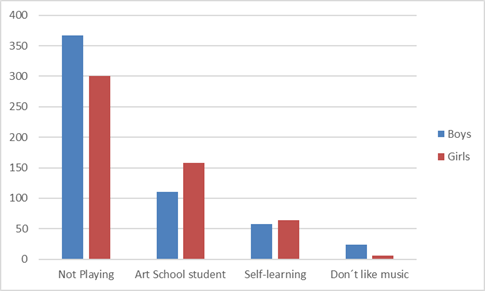
Another aspect focused by our research was investigating into the type of music preferred by pupils of the given age group. Out of the 1,062 respondents, only 30 children (i.e. 2.8%) do not enjoy music. The others listen dominantly to modern music (79% of the respondents), folklore music (8% of the respondents) and other kinds of music (8% of the respondents, i. e. 89 pupils). Classical music is listened to by merely 3% of pupils, which is typical of this age group. The results have been quantified and Figureically illustrated – see Figure No.
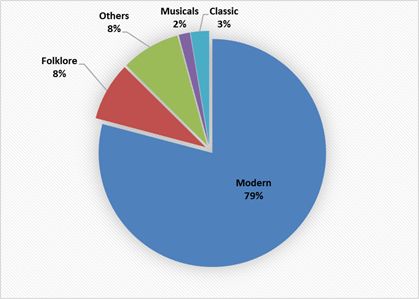
According to the European Reference Framework for Languages, the rich heritage of varied European languages and cultures must be protected and developed. Big pedagogical efforts have to be made to turn this diversity, which can be an obstacle in communication, into a source of mutual enrichment and understanding. (SERR, 2006, p. 2) An active knowledge of foreign languages is essential nowadays – it makes international communication and bigger mobility possible, and it makes the access to information easier. Primary schools in the Czech Republic have to start with the compulsory classes of the first foreign language in the third grade at latest. English is usually offered as the first foreign language. Within the framework of our research, English was indicated as the first foreign language by 1,061 respondents, which means in 100 % cases. German, which is historically deeply rooted in the Czech Republic, is mostly chosen as the second foreign language. In our research, 649 respondents in total gave answers to the question on the second foreign language with these results: German (376 respondents), Russian (156 respondents), French (60 respondents) and Spanish (43 respondents).
Music not only influences a human being´s life, it is also an effective factor within school and out-of-school activities carried out by pupils. If music is made purposefully involved in the teaching process, then it plays both the informative and formative role. Music can motivate and activate pupils; it can be a highlight of the classes. Simultaneously, it provides learners with effective practice of spoken language – pronunciation, rhythm, intonation and language fluency can be effectively practised. Moreover, suitably chosen songs can practise and fix various grammar structures and develop the vocabulary of the target foreign language.
Another issue of our research was the frequency of using music in foreign language classes. The respondents answered the question: “How often do foreign language teachers use music during their classes?“ The obtained results show that from the pupils´ point of view, music is a completely missing element in foreign language classes. Based on the responses made by pupils and students, English teachers involve music into their classes more often than teachers of other languages. Teachers of English seem to be more liberal, and they use music pieces more frequently mainly in classes for very young learners (once a week). In case of classes for pupils of the older school age the frequency is lower (once a month). The situation is even much worse in case of the second foreign language teaching. The teachers of Spanish are the best (they use music once a week), they are followed by teachers of French and Russian. Teachers of German, who apply music in their classes only sporadically, are perceived in the worst way by pupils. The following question can be asked: “Why do teachers of German not use music in their classes when so many music geniuses came from the German speaking world, and even the present production coming from the German speaking areas does not fall behind?“ Making learners familiar with cultural traditions of the target country is an important factor creating learners´ attitude to both the country and the language.
The percentage use of music in foreign language classes at primary and secondary schools in the Czech Republic is illustrated with the following Figures.
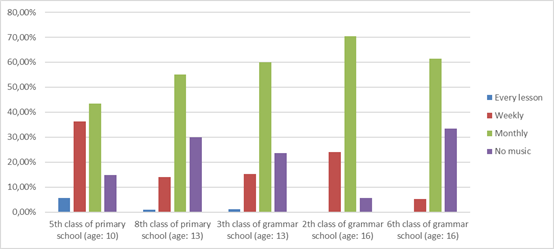
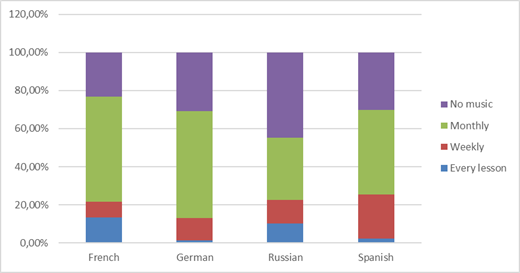
Teachers should carefully choose the music pieces which will be used during foreign language classes. The melody should be easy and easily memorable; the lyrics chosen should respect the language level of the learners (only a small amount of the unknown vocabulary and unknown grammar should be included). The learners´ age level should be respected – easy texts with often repeated parts should be used for younger children; older children prefer modern melodies and lyrics sung by current popular singers. The didactic value of the music texts is also important – they should reflect the topical / lexical / grammar issues taught.
The objective of our further research was to find out which kind of music is most frequently used within the framework of classes of individual foreign languages. The following sub-hypotheses were formulated:
H1: Teachers of English apply mainly modern music in their classes.
H2: Teachers of other foreign languages give preference to folklore music.
The respondents were thus asked about the type(s) of music used by their teachers during their English classes. The obtained data were then quantified (Figure No.
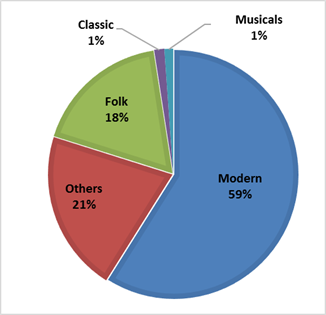
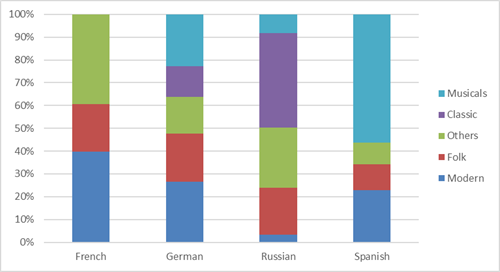
Conclusion
Music has a big pedagogical potential when used in foreign language teaching. Numerous music forms can be used in foreign language classes (classical music, musicals, folklore and modern music, etc.). In our opinion, there are several arguments and reasons for supporting the use of music not only as a relaxing or additional activity when teaching foreign languages. Let us mention social, emotional, cognitive, physiological, linguistic, motivational and inter-cultural reasons at this point.
Music can be applied when practising pronunciation, listening, speech melody and intonation. It can be also used for acquiring new vocabulary and fixation of some grammar structures of foreign languages. Moreover, music offers a possibility of pupils´ identification with its authors or interprets because songs, as literary texts, reflect the authors´ feelings, capture interpersonal relations, various forms of love, mutual alienating, diseases, etc. (Heinrichová, 2015, p. 66) Our research revealed that foreign language teachers only sporadically use music as a means of foreign language teaching. Music is most often applied in classes of English; teachers of German use music least of all. This means that Hypothesis No. 3 formulated by us (Involvement of music varies with teaching of different foreign languages.) was confirmed. Our research also confirmed Hypothesis No. 1 (Music is involved in foreign language classes more frequently in case of younger learners than in case of learners of the older school age.). Our second hypothesis (Pupils, resp. students of the older school age are confronted with music much more often in their personal life than in the course of foreign language classes.) was not effectively verified within the framework of our research. But we believe that with growing subjectivism and tendencies to introversion typical of the adolescent age, the interest in music is deepening and music creativity is developing. Therefore it is a pity that teachers of foreign languages do not use the big potential of music within the framework of their classes.
Involvement of music into foreign language teaching is generally considered as being fruitful. Music is not only a source of motivation for learning but it can also be beneficial for the consolidation of the knowledge of the foreign language. Vágnerová (2012, p. 114) says that music develops a child´s hearing and consequently the child´s diction, articulation and dynamism of his / her speech gets improved, and the child also learns foreign languages more easily. Aignerová (2002/2003, p. 25) adds to that that conveying of new structures and their automatizing through music is a very efficient method of language acquisition. The learning process is easier and faster, learners are able to realize simple conversations very soon, and the feeling of being successful is motivating. Music can be used for improving of learners´ communicative abilities and knowledge of the culture and language. The language skills can be acquired in non-isolated ways through real language situations and communicative tasks. The material for these can be offered by folklore or modern songs. Music can have a wide and varied application in foreign language teaching. As Besedová (2016, p. 651) says, music and foreign languages are means of communication which use listening materials and simultaneously they develop learners´ perceptiveness of the surrounding world and their creativity. Music´s potential thus should be fully used in foreign language teaching.
References
- Aignerová, Alena (2002/2003). Píseň v cizojazyčném vyučování. In: Cizí jazyky, r. 46, č. 1, s. 23 – 25. ISSN 1210-0811.
- Badstübner-Kizik, Camilla (2014). Text – Bild – Klang. Ästhetisches Lernen im mehrsprachigen Medienverbund. In: Bernstein, Nils; Lercher, Charlotte (Hrsg.): Ästhetisches Lernen im DaF-/DaZ-Unterricht. Göttingen: Universitätsverlag, s. 297-312. ISBN 978-3-86395-183-2.
- Besedová, Petra (2016). Music as an intercultural medium in foreign language teaching. In: Bekirogullari, Z., Minas, M. Y., Thambusamy, R. X. (ed.): The European Proceedings of Social and Behavioural Science Ep-SBS. Rhodes-Greek 2016, s. 646 – 662, e-ISSN 2357-1330. online: http://www.futureacademy.org.uk/publication/EpSBS/ICEEPSY_2016
- Besedová, Petra (2015). Der Einsatz von Musik im Fremdsprachenunterricht. In: SUNG (Hrsg.) Slowakische Zeitschrift für Germanistik. Jahrgang 7, Heft 1, s. 58 – 71. ISSN 1338-0796.
- Gardner, Howard (1999). Dimenze myšlení: teorie rozmanitých inteligencí. Praha: Portál. ISBN 80-7178-279-3.
- Heinrichová, Naděžda (2015). Německá próza po roce 2000. Červený Kostelec: Pavel Mervart. ISBN 978-80-7465-183-0.
- JÄNCKE, Lutz (2012). Macht Musik schlau? Neue Erkenntnisse aus dem Neurowissenschaften und der kognitiven Psychologie. Bern: Hans Huber Verlag. ISBN 978-3-456-84575-3.
- Kalhous, Zdeněk; OBST, Otto (2002). Školní didaktika. Praha: Portál. ISBN 978-80-7367-571-4.
- Kerer, Manuela a kol. (2009). Demenz und Musik. In: Neuropsychiatrie (23), č. 1/2009, s. 4 - 14.
- Lenčová, Ivica (2008). Literárny artefakt vo výučbe cudzích jazykov. Banská Bystrica: Fakulta humanitných vied, Univerzity Mateja Bela. ISBN 978-80-8083-572-9.
- Mareš, Jiří (2013). Pedagogická psychologie. Praha: Portál. ISBN 978-80-262-0174-8.
- Nakonečný, Milan (2003). Úvod do psychologie. Praha: Academia. ISBN 80-200-0993-0.
- Ondráková, Jana (2012). Rozdíly v učení jazyků u dětí a dospělých. In: Ondráková, Jana; Tauchmanová, V. a kol. (eds) Vzdělávání seniorů a jeho specifika. Vyd. 1. Červený Kostelec: P. Mervart, 168 s. ISBN 978-80-7465-038-3.
- Ondráková, J. (2014) Education of Seniors at Universities of the Third Age. In: Psychology and psychiatry, sociology and healtcare, education (SGEM 2014). Sofia: Bulgaria. Step92, volume III, pp 257-264. ISBN 978-619-7105-24-7.
- Perner, Mathias (2014). Musik im DaF-Unterricht: Von der Sprache zur Musik – und zurück. In: Bernstein, Nils; Lercher, Charlotte (Hrsg.): Ästhetisches Lernen im DaF-/DaZ-Unterricht. Göttingen: Universitätsverlag, s. 313 – 334. ISBN 978-3-86395-183-2.
- Pless, Ulrike (2014). Übersetzen von Liedern im DaF-Unterricht. In: Bernstein, Nils; Lercher, Charlotte (Hrsg.): Ästhetisches Lernen im DaF-/DaZ-Unterricht. Göttingen: Universitätsverlag, s. 151 – 166. ISBN 978-3-86395-183-2.
- Průcha, Jan (2013). Moderní pedagogika. Praha: Portál. ISBN 978-80-262-0456-5.
- Průcha, Jan; Walterová, Eliška; Mareš, Jiří (2013). Pedagogický slovník. Praha: Portál. ISBN 978-80-262-0403-9.
- Rampillon, Ute (2000). Selbstevaluation als Auslöser konstruktiver Lernprozesse. In: Wendt, Michael (Hg.) Konstruktion statt Instruktion. Neue Zugänge zu Sprache und Kultur im Fremdsprachenunterricht. Frankfurt a/M, Berlin: Lang, s. 119 – 142. ISBN 3-361-37568-9.
- Saffran, Jenny R.; Griepentrog, Gregory J. (2001). Absolute Pitch in Infant Auditory Learning: Evidence for Developmental Reorganization. In: Developmental Psychology, 37, s. 74 – 85. ISSN 0012-1649.
- Sedlák, František; Váňová, Hana (2013). Hudební psychologie pro učitele. Praha: Karolinum. ISBN 9788024620602.
- Serr, Společný evropský referenční rámec pro jazyky (2006). Olomoluc: Univerzita Palackého. ISBN 80-244-1425-2.
- Schmitz, Stefanie (2012). Singen statt Vokabeln pauken. Fremdsprachenlernen mit musikalischer Unterstützung. Hamburg: Diplomica. ISBN 978-8428-8575-2.
- Siegler, Robert; Deloache, Judy; Eisenberg, Nancy (2011). How children develop. New York: Worth publishers. ISBN 978-1-4292-1790-3.
- Spitzer, Manfred (2014). Musik im Kopf. Hören, Musizieren, Verstehen und Erleben im neuronalen Netzwerk. Stuttgart: Schattauer. ISBN 978-7945-2940-7.
- Sternberg, Robert J. (2002). Kognitivní psychologie. Praha: Portál. ISBN 80-7178-376-5.
- Vágnerová, Marie (2012). Vývojová psychologie. Dětství a dospívání. Praha: Karolinum. ISBN 978-80-246-2153-1.
- Werker, Janet, F.; Desjardins, Renée, N. (1995). Listening to speech in the 1st year of life: Experiential influences on phoneme perception. In: Current Directions in Psychological Science, Vol. 4, No. 3, s. 76 – 81.
- Wicke, Rainer – Ernst (2000). Grenzüberschreitungen. Der Einsatz von Musik, Fotos und Kunstbildern im Deutsch-als-Fremdsprache-Unterricht in Schule und Fortbildung. München: Iudicium. ISBN 3-89129-628-2.
Copyright information

This work is licensed under a Creative Commons Attribution-NonCommercial-NoDerivatives 4.0 International License.
About this article
Publication Date
16 October 2017
Article Doi
eBook ISBN
978-1-80296-030-3
Publisher
Future Academy
Volume
31
Print ISBN (optional)
-
Edition Number
1st Edition
Pages
1-1026
Subjects
Education, educational psychology, counselling psychology
Cite this article as:
Besedová, P., Štočková, K., & Šeslerová, A. (2017). Student´s Attitude To Music In Foreign Language Lessons. In Z. Bekirogullari, M. Y. Minas, & R. X. Thambusamy (Eds.), ICEEPSY 2017: Education and Educational Psychology, vol 31. European Proceedings of Social and Behavioural Sciences (pp. 71-82). Future Academy. https://doi.org/10.15405/epsbs.2017.10.8

